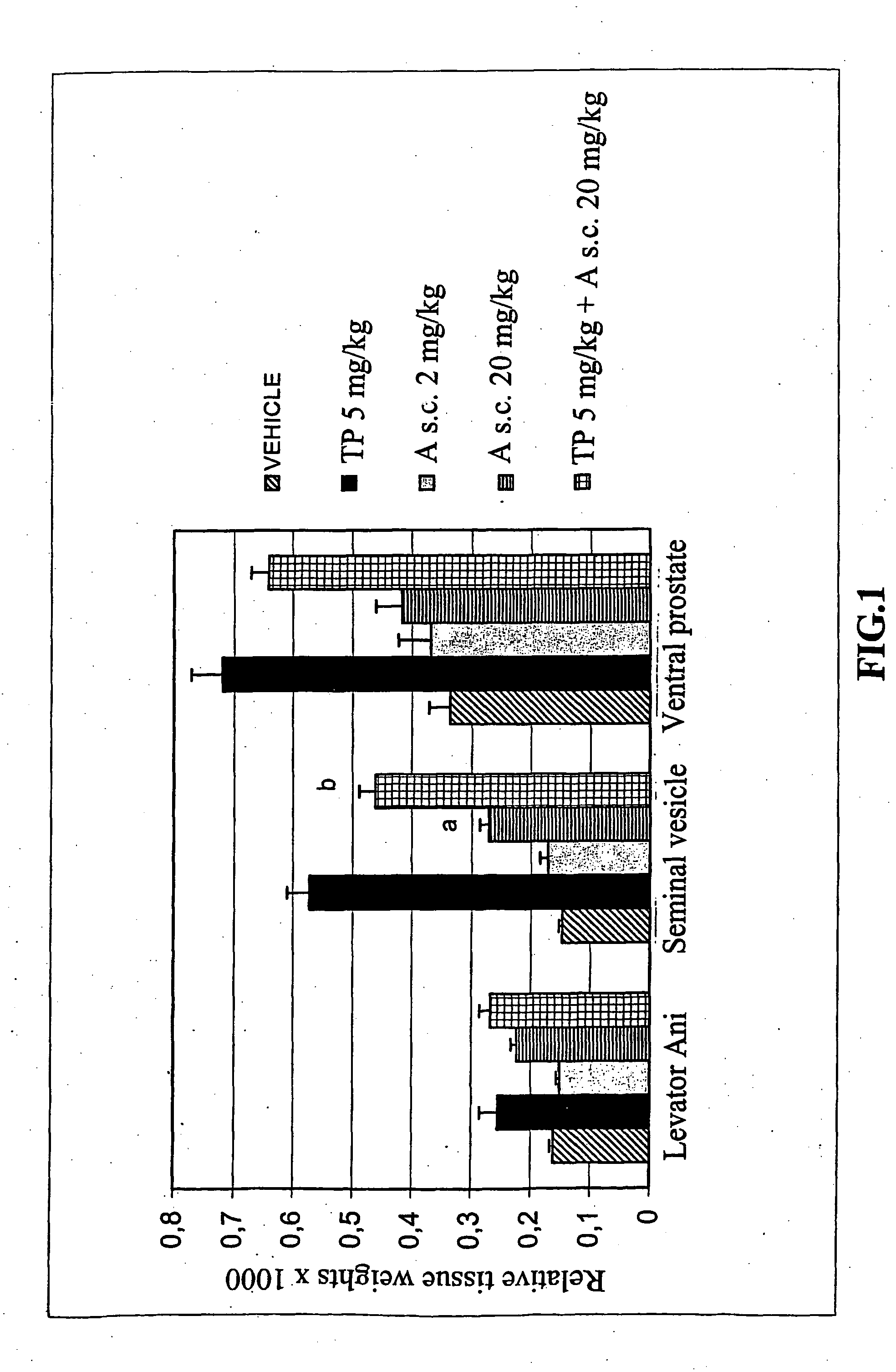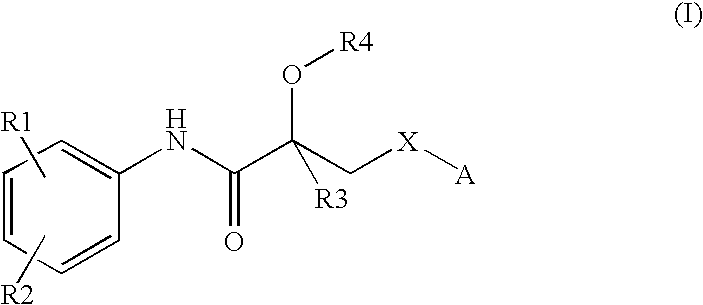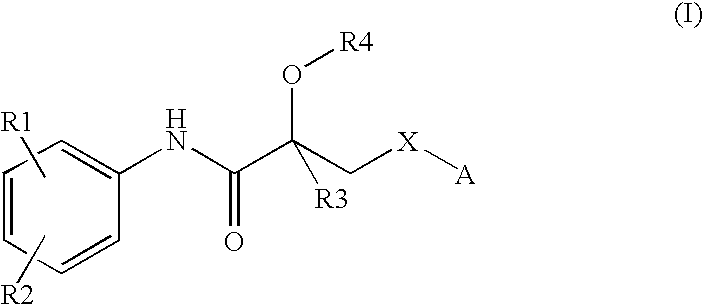Propionamide derivatives useful as androgen receptor modulators
a technology of androgen receptor and propionamide, which is applied in the field of therapeutically active compounds, can solve the problems of low systemic bioavailability after oral administration, severe limitations of current steroidal androgens, and the rapid degradation of testosterone, and achieves the effects of beneficial androgenic effects, high affinity and activity of androgen receptors, and convenient us
- Summary
- Abstract
- Description
- Claims
- Application Information
AI Technical Summary
Benefits of technology
Problems solved by technology
Method used
Image
Examples
example 1
)
3-(4-Acetylaminophenoxy)-2-hydroxy-2-methyl-N-(3-methyl-4-nitrophenyl)-propionamide
a) 2-Methyl-N-(3-methyl-4-nitrophenyl)acrylamide
[0096] 3-Methyl-4-nitroaniline (2.0 g, 13 mmol) in N,N-dimethylacetamide (DMAC) (6 ml) was added dropwise to a cooled solution of methacryloyl chloride (2.0 ml, 20.7 mmol) in a nitrogen atmosphere while the temperature of the reaction mixture was maintained between 0-5° C. The solution was allowed to warm to room temperature and the mixture was stirred over night. The mixture was poured into water (70 ml) and extracted with ethyl acetate (4×40 ml). The organic phase was washed with saturated Na2CO3 (3×20 ml) and water (1×50 ml), dried over Na2SO4 and evaporated. The yield of the crude product was 4.17 g (contains DMA, theoretical yield 2.9 g), and it was used without further purifications. 1H NMR (DMSO-d6): 1.97 (3H, s), 2.55 (3H, s), 5.62 (1H, m), 5.96 (1H, m), 7.80 (2H, m), 8.05 (1H, m), 10.22 (1H, s).
b) 2-Methyloxirane-2-carboxylic acid (3-methyl-...
example 2
3-(4-Acetylamino-3-fluorophenoxy)-2-hydroxy-2-methyl-N-(3-methyl-4-nitrophenyl)propionamide
a) N-(2-Fluoro-4-hydroxyphenyl)acetamide
[0099] Acetic anhydride (1.3 ml, 13.8 mmol) was added dropwise to a solution of 4-amino-3-fluorophenol (1.0 g, 7.9 mmol) in acetic acid (25 ml) at room temperature. The reaction mixture was stirred at room temperature for 2 h and water (2 ml) was added and the stirring was continued for 30 minutes at room temperature. The mixture was evaporated to dryness in vacuo. The yield of the crude product was 1.3 g (100%) and it was used without further purification. 1H NMR (DMSO-d6): 2.00 (3H, s), 6.50-6.68 (2H, m), 7.39 (1H, m), 9.39 (1H, s), 9.72 (1H, s).
b) 3-(4-Acetylamino-3-fluorophenoxy)-2-hydroxy-2-methyl-N-(3-methyl-4-nitrophenyl)propionamide
[0100] The compound was synthesised according to the procedure described in Example 1c. N-(2-Fluoro-4-hydroxyphenyl)acetamide (0.5 g, 3.0 mmol) and 2-methyloxirane-2-carboxylic acid (3-methyl-4-nitrophenyl)amide (0...
example 3
)
(2S)-3-(4-Acetylaminophenoxy)-2-hydroxy-2-methyl-N-(3-methyl-4-nitrophenyl)propionamide
a) (2R)-1-(2-Methylacryloyl)pyrrolidine-2-carboxylic acid
[0101] D-proline (5 g, 43.4 mmol) was dissolved in 2 M NaOH (26 ml) and cooled in an ice bath, and the solution was diluted with acetone (26 ml). An acetone solution (26 ml) of methacryloyl chloride (6.3 ml, 65.1 mmol) and a 2 M NaOH solution (34 ml) were simultaneously added over a period of 1 h to the solution of D-proline. After addition the resulting mixture was stirred for 3 h at room temperature. The mixture was evaporated at 40° C., extracted with ether (2×40 ml) and acidified to pH 2 with concentrated HCl. The resulting mixture was extracted with ethyl acetate (3×50 ml), dried over Na2SO4 and evaporated. The yield was 11.5 g (theoretical 8.0 g), and it was used without further purifications.
b) (3R,8aR)-3-Bromomethyl-3-methyltetrahydropyrrolo[2,1-c][1,4]oxazine-1,4-dione
[0102] NBS (16 g, 89.9 mmol) was dissolved in DMF (50 ml) an...
PUM
| Property | Measurement | Unit |
|---|---|---|
| Composition | aaaaa | aaaaa |
Abstract
Description
Claims
Application Information
 Login to View More
Login to View More - R&D
- Intellectual Property
- Life Sciences
- Materials
- Tech Scout
- Unparalleled Data Quality
- Higher Quality Content
- 60% Fewer Hallucinations
Browse by: Latest US Patents, China's latest patents, Technical Efficacy Thesaurus, Application Domain, Technology Topic, Popular Technical Reports.
© 2025 PatSnap. All rights reserved.Legal|Privacy policy|Modern Slavery Act Transparency Statement|Sitemap|About US| Contact US: help@patsnap.com



